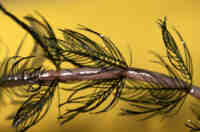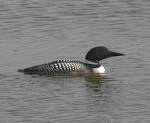Greetings!This update is the third in a series of reports the Minnesota Department of Natural Resources (MDNR) is sending to Leech Lake area resorts, businesses, and others interested in DNR activities on Leech Lake. The goal of these messages is to keep you up to date with our findings and our current activities on the lake. As always, please contact our office
(Walker Area Fisheries Office, 07316 State Hwy. 371 NW, Walker, MN 56484 (218) 547-1683) if you have any questions or comments.
Leech Lake GillnettingThe Walker Area Fisheries office finished the gillnet survey of Leech Lake on September 15. Since 1983, Leech Lake is sampled annually with gillnets. Nets are set in the same locations and at the same time of year. In this way, we can compare net catches from year to year. What we found was very encouraging! The overall gillnet catch of walleye was 7.1 per net, up from 4.9 per net last year. The catch rate was even higher in the main lake (8.7 per net). While large walleye are still present in good numbers, nearly one-half of the walleye catch were from the 2005 and 2006 year classes. Further, growth of age 1 walleye (2005 year class) indicates they will reach keeper sizes early next year. We are hearing some fall anglers are keeping walleye that are 13 inches in length. There is more good news from our gillnet survey. The catch of yellow perch in the main lake increased dramatically from last year, primarily perch less than 7 inches in length. This is likely the result of good natural reproduction and the double-crested cormorant control over the past two years. With a larger population of small yellow perch currently in the lake, better catches of big yellow perch are likely to follow in the coming years. Anglers this fall, however, are catching good numbers of big yellow perch. If you are interested in other information from our surveys, please call, email or stop by the office.
 MPCA Looks for Mercury in Leech Lake Fish
MPCA Looks for Mercury in Leech Lake Fish
Most fish are healthy to eat and are an excellent source of low-fat protein. Eating fish may also reduce the risk of heart disease, diabetes and other chronic illnesses. But any fish (store-bought or sport-caught) could contain contaminants such as mercury and PCBs that can harm human health - especially the development of children and fetuses. You can't see, smell, or taste the mercury or PCBs in fish. That's why it is important to know which fish are safer than others to eat. The Minnesota Pollution Control Agency (MPCA) tests fish from Leech and other lakes on a periodic basis. This year, the Walker Fisheries Area office sent walleye, northern pike, and yellow perch to the MPCA to once again check mercury levels in Leech Lake fish. Previous tests have found very low levels of mercury (see this link for current Leech Lake guidelines
http://www.dnr.state.mn.us/lakefind/fca/report.html?downum=11020300).
The DNR website will be updated if there is a change in consumption advisory. For more information on eating fish, please visit:
http://www.health.state.mn.us/divs/eh/fish/eating/index.htmlEurasian Water Milfoil is Hard to FindOn August 8, staff from the DNR’s Ecological Services Division in Brainerd made a search for Eurasian water milfoil in Leech Lake. Originally found growing in five harbors in 2004, areas that continued to have the invasive exotic were treated with an herbicide earlier in the summer. The August inspection found very few plants and in only two locations. While it is not likely possible to eradicate Eurasian water milfoil from Leech Lake, aggressive treatment and follow-up seems to be keeping it in check. For more information on Eurasian water milfoil, please visit:
http://www.dnr.state.mn.us/ecological_services/invasives/ewmprog.html 
Of InterestMany Leech Lake residents and tourists note the large number of loons seen on Leech Lake counted common loons (
Gavia immer) weekly onlakes Winnibigoshish and Mille Lacs to determine premigratory numbers, flock sizes and locations. Counts were made from shore, boat and plane. On Lake Winnibigoshish, the highest count was recorded on October 21 with 1,599 loons. On Lake Mille Lacs, thighest count total occurred on October 20 with 1,688 loons, a record high count for any lake in Minnesota at any time. Minnesota has more loons than any other state in the lower 48.
 Contact Information
Contact InformationPat Rivers (
pat.rivers@dnr.state.mn.us) or Harlan Fierstine (
harlan.fierstine@dnr.state.mn.us)
 I was at Leech Lake for the MEA week in Minnesota (Oct. 14-22) and it was a nasty week weather wise. Temperatures were colder than normal, in the mid-20s to low-30s, and it was windy several days during my stay.
I was at Leech Lake for the MEA week in Minnesota (Oct. 14-22) and it was a nasty week weather wise. Temperatures were colder than normal, in the mid-20s to low-30s, and it was windy several days during my stay.






